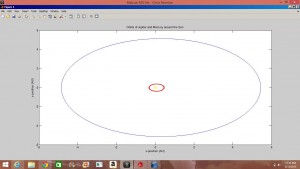The precession of Mercury is caused by the gravitational effects of the other planets (Jupiter contributing the most) and the general relativistic effects of the Sun. In the first part of my project I set about achieving the value of the precession of Mercury using the Euler-Chromer method to simulate Mercury’s orbit and least-square linear fits of ![]() and precession rate vs.
and precession rate vs. ![]() . I achieved a value of
. I achieved a value of ![]() , with a percent error deviation of 10.39 from the true value,
, with a percent error deviation of 10.39 from the true value, ![]() .
.
In the second part of my project, I let the eccentricity of the orbit of a Mercurian-sized body vary in its orbit in order to observe eccentricity’s effect on the precession rate. I determined that precession rate is inversely proportional to ![]() . The values of
. The values of ![]() and eccentricity I used are included in a table attached to this post.
and eccentricity I used are included in a table attached to this post.
This past week I experimented with 3-body systems in order to determine the effect of Jupiter on Mercury’s precession. Using the Euler-Chromer method I was able to successfully model a Jupiter-Mercury-Sun system, but only when the Sun’s position and velocity were held at 0.
For the case in which the Sun was to be given an initial position and velocity, I input parameters that should have allowed the center of mass to remain constant, however the graphs showed the Sun escaping from the solar system. Unfortunately I’m not sure how this error occurred, however I am convinced that this model is necessary to determine Jupiter’s effect on Mercury’s precession, as I was unable to achieve the correct value with the model in which the Sun’s position and velocity were held constant.
Link to Code:
https://docs.google.com/a/vassar.edu/document/d/1DrX3F-mnJsyuq8FPltXRY8aCFyNxQvoUGUG_BoIpiBE/edit?usp=sharing
Link to Eccentricity Data:
https://docs.google.com/a/vassar.edu/spreadsheets/d/1YNlhVNkyhy-arqPQW5dAoME6pCHRKIlXpKaZ6bisG-s/edit?usp=sharing



Hey everyone here I need some help with my natural science and technlogy I need a conclusion about mercury and jupiter I really nee it can someone help me
Angelica, the results from your investigation of mercurian orbits using computational modeling are really impressive. As someone who has not taken any astronomy or cosmology being able to literally see how the perihelion of mercury and its eccentricity are changing as the body orbits the sun was very informative.
Project Proposal:
You gave a great introduction to the problem you wanted to investigate. And the brief information you gave regarding procession, the expected missing values, and the methods you would be employing for this project were very helpful in getting a glimpse of your work.
Project Plan:
The mathematical background you presented was helpful in understanding how you would be incorporating the Euler-Chromer method without the bore of a rigorous and lengthy derivation of the difference equations. And you clearly outlined what values you were looking for and the technique you’d be using to discover those values. Additionally, your planned your project out with very attainable weekly goals.
It would have been nice to see some explanation of how general relativity is affecting the precession of mercury’s orbit. A brief description of space time curvature due to the mass of the sun would be great either here or in your project proposal post.
Preliminary Results:
You gave a succinct update on the progress of your code and your findings. The graph you provided was titled and labeled well. Perhaps a short section (in the post) explaining your assumptions for the program would be helpful here.
In terms of presentation, although the figure you included was nicely labeled, it would be advantageous to use Matlab’s functions to take a capture of the figure without having to capture your desktop and toolbars.
Your code is really well commented!
Data and Results:
You laid out your results and your statistical analysis of the procession values effectively. I think it would also be important in future work to include not just percent error but also the certainty in your values. And your comment of mercury’s eccentricity where you describe the fitting data and relating that back to Einstein’s expression is a great way to illustrate the relationship between your numerical methods and the analytical ones.
Again, your code is very nicely commented and separated. In reviewing your codes, I think that it would be helpful to include information regarding the run time of the code.
Conclusion:
Great overview! You hit the most important point of your complete project. And the 3-body problem including Jupiter was a great bonus; it was very illustrative of the orbital procession.
Overall you did a great job with presenting your project!
It is always good to recognize your own errors. Where would you go from here if you had more time? Could you represent the alpha and eccentricity values in a graph? I thought you did in the past…